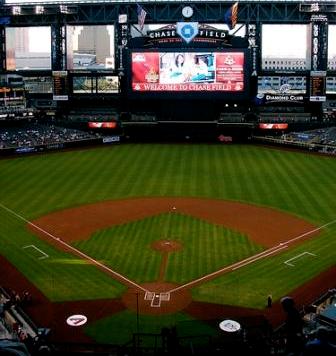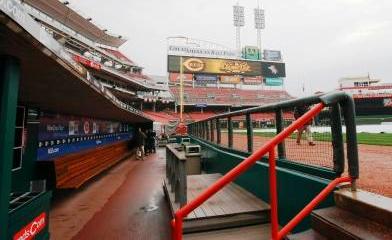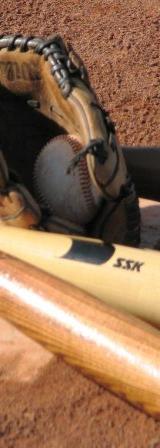Base Runner Continues to Run to Rule Baseball Tag Out Rules
~ Baseball Rules; First Base Running Lane. Why Is It There And What Is It's Purpose? ~
Baseball rules, first base running lane. What is it and why is it there?
As you look out onto a baseball field, regardless of its' dimensions, you will notice a chalk line marked along the first base foul line, in foul territory.
This line starts halfway to first base and extends to the backside of the first base bag.

The first base line is the only double baseline. It designates what is called the "first base running lane".
THE RULE
- The batter-runner is required to run in this three foot zone, the last half of the distance to first base.
- Both feet must be in or over the 3' zone, one foot in and one foot out is not good enough.
- If both feet are in the lane; but the throw hits the runners' arm, which is outside the lane, there is no violation.
- If the runner is hit by the throw or a collision occurs on his last step before touching the base, generally interference is not called. The runner has to step into fair territory to touch the base, which is in fair territory.
- The batter-runner is out if, in running to first base, he is hit with a throw while he is running outside the 3' running lane, or interferes with the fielder taking the throw at first base. He could be called out even if he is not hit with the throw, if the umpire judges that by being outside the lane he interfered with the fielders attempt to field the throw.
- There must be a throw before interference is called and the throw must be a quality throw.
- The baseball rule states that he is out when out of the lane and causes interference with the fielder taking the throw.
Baseball Rules Tips ~ From the Dugout

Essentially, a batter-runner must be running in the first base running lane, or risk the possibility of being called out due to interference with the player attempting to catch the throw, or obstructing the player making the throw.
There must be a throw and it must be a quality throw, that is a ball that had a reasonable chance of being caught.
This situation occurs with batted or bunted balls out in front of home plate, or up along the first base line.
It also occurs on dropped third strikes, or passed ball third strikes with first base unoccupied, or with two outs and first base occupied.
Why Is The Line There
The line is there to provide the umpires with a visual guide with which to make a decision.
It is also there as a guide for the batter-runner to know at what point he must be in that running lane, so as not to be called for interference. The line begins half way to first base, distance dependent upon the dimensions of the field.
Drill Possibilities
EQUIPMENT NEEDED
- Field with bases.
- Baseballs.
- Available coaches.
- Catchers with full gear.
- Pitchers with gloves.
- Base runners with helmets.
- First baseman and second baseman with gloves.
- Chalked running lane. You can substitute cones, if chalked lane isn't available for practice.
GOALS AND SKILLS DEVELOPED
- Main goal ~ Provide players with an offensive understanding of what the running lane is, and when and why they must be in it.
- Secondary goal ~ Drill opportunities for catchers, pitchers, first and second basemen.
- Additional skill development ~ Communication between the defensive positions, fielding and throwing work with live runners, base runners drill on dry swing, getting out of the box and running in the lane, as well as Lean, Look, Stutter and team conditioning.
Baseball Rules ~ First Base Running Lane ~ Drill Set Up
- Pitchers on mound with glove, no ball.
- Catchers, full gear, at home plate.
- First basemen at first base.
- Second basemen at second base.
- All other players at home plate, with helmet on.
- Coaches ~ One at home plate to roll baseballs in front of home plate, up the first base line, and out to the sides and rear to simulate blocked third strikes in the dirt and passed balls. If no other coaches available, one coach can work it alone. Position additional coaches at each of the areas being drilled.
The Drill
- Pitcher goes through motion of throwing a ball.
- Batter/runner, with helmet, goes through hitting progressions and runs to first base.
- Coach at home plate rolls ball out onto field, as the hitter swings.
- Catcher reads ball and situation, makes call.
- First baseman covers first base, and yells out where he wants the ball to be thrown, inside or outside.
- Second baseman comes over to backup first base, or cover first base if the first baseman has charged on a bunt. Second baseman must also then, make the call for where he wants the ball thrown.
- Additional available coaches take an area of the drill to provide instruction.
Coaching Tips
- First baseman must decide which side of the base he would like the throw, inside or outside, dependent upon where the ball is fielded. Yell it out loud!
- Catcher and pitcher must communicate as to who is fielding the ball, yelling it out so that they do not collide.
- On passed balls, pitcher needs to point out to the catcher where the ball is, and tell him "no throw"or "hold it", if he has no chance on the play.
Getting More For Your Time And Money
- Take it live. Hitters can work on their base hit bunt game.
- Add right fielders, they can work on correct back up angles.
- This is an area often over looked. When the outfielder fails to move to back up, as soon as he sees the play develop, an over throw results with the base runner ending up on second base at the minimum, often times third base.
- Add third basemen and work all balls out in front and up both lines.
Ultimately these skills can be incorporated into the team situation, fungo drill as a part of total team defense.
Easy to do, quick to run, until you add the "live" part. That variation can slow down significantly, depending on the pitcher, as well as the hitter.
I feel it is still worth doing at real speed, for the skills you are able to work on.
Baseball Rules
Rules ~ A working knowledge of baseball rules is essential for players to feel comfortable and enjoy success within the game. Tagging Up ~ The base runner can go when..... Force Removed ~ As an infielder, what do I do now? return from baseball rules first base running lane to theoleballgame.com 

Source: https://www.theoleballgame.com/baseball-rules-first-base-running-lane.html
0 Response to "Base Runner Continues to Run to Rule Baseball Tag Out Rules"
Post a Comment